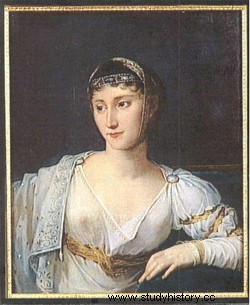Princess Borghese (Ajaccio, October 20, 1780 - Florence, June 9, 1825).

Pauline Bonaparte, born Paoletta, is the second daughter of Charles-Marie Bonaparte and Maria-Létizia Ramolino, and the most beautiful of Napoleon Bonaparte's sisters. She was born on October 20, 1780 in Ajaccio, in the family home, and died on June 9, 1825 in Florence. She was Napoleon's favorite sister.
Youth
Very little is known about the first years of his life. In 1793, at the age of 13, she followed her mother, brothers and sisters, in flight to the Continent, after the family choice of the Revolution. She will be quickly courted first, at the Château Salé in Antibes where the family lives after the Siege of Toulon, by Andoche Junot who has become Bonaparte's aide-de-camp, then by the Conventional Stanislas Fréron, whom Bonaparte does not want to hear about. To cut this idyll short, Bonaparte brought Paoletta to the castle of Mombello, near Milan, where he already reigned like a proconsul...
Wedding
Napoleon Frenchified her first name in Pauline and made her marry in 1797 Victor Emmanuel Leclerc, one of the best generals of the Republic after having refused his hand to Duphot, the one who died in Rome in 1797, during a riot. Later, the younger sisters of General Leclerc will marry, one the future Marshal Davout and the other Major General Friant. The marriage was celebrated on June 14, 1797. The following year they had a son named Dermid, a first name from the poetry of Ossian. She accompanied her husband on the expedition to Santo Domingo (now Haiti), intended to put down the rebellion led by Toussaint Louverture.
Despite her brother's position, and her husband's frequent absences on campaign, Pauline had many affairs in Santo Domingo, often with low-ranking soldiers and officers. Although she was unfaithful, Pauline courageously took care of her husband, who had contracted yellow fever. He ended up dying on November 1, 1802. Pauline's despair was spectacular, she cut her hair and placed it in her coffin. She had her husband's heart placed in an urn and repatriated the funeral remains to France.
The First Consul quickly looked for a new husband and found him in the person of Camille Borghèse. He is a Roman prince with a rich palace, vast estates and a good income. After the wedding in 1803 in Mortefontaine in the property of Joseph, Napoleon bought the art collection of the Borgheses which he intended for the Louvre Museum. Pauline quickly got tired of Rome and went to live in the Château de Neuilly, where she held a kind of court, while Camille Borghese left for the army in the Consular Guard. In 1804, Pauline had the pain of losing her young son Dermid who had always been of weak constitution. But a few months later, Princess Borghese, she attends the coronation. She then lived in the Faubourg Saint-Honoré in this Charost hotel (later to become the British Embassy).
In 1805, Camille Borghèse, squadron leader left for the camp of Boulogne then was assigned to the German army, as colonel of riflemen and named general in 1807.
Pauline was elevated to the rank of Princess of Guastalla in 1806. However, she was always suspicious of Marie-Louise. This attitude earned him a cold with his brother.
Fall of Napoleon and Loyalty
The relationship between Pauline and Napoleon was marked by a deep bond of fidelity and benevolence, unlike Napoleon's other brothers and sisters. Being Napoleon's greatest admirer, she always remained faithful to him. She was the only Bonaparte to visit him during his exile on the island of Elba. She used her own funds to improve Napoleon's lifestyle in Elba (she made available to him her diamonds which were taken from Waterloo in the Emperor's car). In her last years, she became close to Prince Borghese, and, pressed by Pope Leo XIII, lived with him in Florence. Her health declined and she died of illness on June 9, 1825 in Florence, childless, worried for having tried to repatriate her brother from Saint Helena. His coffin was transported to Rome and rests today in the Borghesiana Chapel at Santa Maria Maggiore in Rome.
Venus of Canova
She was one of the most beautiful women of her time. The sculptor Canova immortalized the beauty of Pauline Borghese in a sublime marble Venus of Praxiteles, lying on a divan, simply dressed in a sheet covering her legs.
